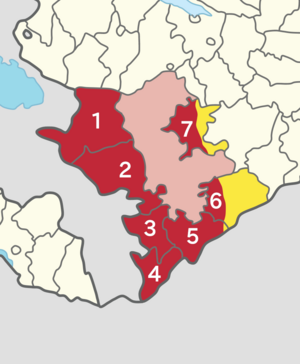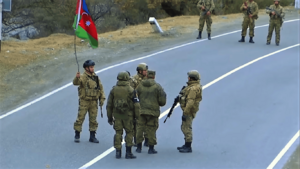Armenian-occupied territories surrounding Nagorno-Karabakh facts for kids
The Armenian-occupied territories around Nagorno-Karabakh were parts of Azerbaijan. These areas were taken over by Armenian military forces from the end of the First Nagorno-Karabakh War (1988–1994) until 2020. The Armenian forces were from the self-declared Republic of Artsakh (also known as the Nagorno-Karabakh Republic), with help from Armenia.
These areas were taken to create a "security belt." This was meant to be traded for Azerbaijan recognizing Nagorno-Karabakh's independent status. In 2020, during the Second Nagorno-Karabakh War, most of these lands were returned to Azerbaijan. Some were taken back by force, and others were given back as part of a 2020 Nagorno-Karabakh ceasefire agreement. Only the Lachin corridor remained under different control for a while.
The United Nations Security Council passed four resolutions during the First Nagorno-Karabakh War. These resolutions asked all occupying forces to leave the lands around Nagorno-Karabakh. In 2008, the United Nations General Assembly also asked Armenian forces to leave all occupied Azerbaijani territories. Unlike the Nagorno-Karabakh Autonomous Oblast, most people living in these surrounding districts were Azerbaijani.
After the Second Nagorno-Karabakh War in 2020, Azerbaijan took back control of Fuzuli, Jabrayil, Zangilan, and Qubadli districts. Armenia also agreed to pull its forces out of Agdam, Kalbajar, and Lachin districts. These areas were returned to Azerbaijan in late 2020. This agreement was part of a ceasefire deal arranged by Russia. Russian peacekeepers were sent to help keep the peace.
Contents
History of the Conflict
At the start of the 1991–1994 Karabakh conflict, the Nagorno-Karabakh Autonomous Oblast was mostly Armenian. However, it was surrounded by areas where most people were Azerbaijani. It did not have a direct land connection to Armenia.
- On May 18, 1992, Armenian forces took control of Lachin. This opened the Lachin corridor, creating a land route between Nagorno-Karabakh and Armenia.
- In 1993, Armenian forces launched a strong attack. This led to them taking more land for a "security zone."
- On March 27, 1993, Armenian forces attacked Kalbajar. By April 5, they had fully taken over the Kalbajar District. This created a strong link between Nagorno-Karabakh and Armenia. It also made the Lachin corridor safer from attacks from the north.
- On July 23, 1993, after 40 days of fighting, Agdam was occupied.
- Then, attacks began in the south. On August 22, 1993, Fuzuli was occupied.
- On August 25, 1993, Jabrayil was occupied.
- On August 31, 1993, Qubadli was occupied.
- On October 29, 1993, Zangilan was occupied.
From 1994 until the 2020 war, Armenians controlled most of the former Nagorno-Karabakh Autonomous Oblast. Azerbaijan controlled some eastern parts of the Martuni and Mardakert areas. During this time, Armenians also occupied all the land between the former Nagorno-Karabakh Autonomous Oblast and Iran. They also held the land between the former Nagorno-Karabakh Autonomous Oblast and Armenia, plus some areas east of Aghdam.
Since 1994, Armenia and Azerbaijan have talked about the future of these occupied lands. Armenia suggested trading "land for status." This meant returning the occupied lands to Azerbaijan. In return, Azerbaijan would recognize Nagorno-Karabakh's independence and promise its safety. Azerbaijan offered "land for peace." This meant returning the occupied lands to Azerbaijan for security promises, with Azerbaijan controlling Nagorno-Karabakh.
Territory and Population Before 2020
Most of the people living in these occupied territories were Azerbaijani. They were forced to leave their homes during the conflict. They became IDPs (people displaced within their own country) in Azerbaijan.
In 2005, a mission from the OSCE visited these areas. They found that about 14,000 Armenian settlers lived there. The towns and villages that existed before the conflict were mostly empty and in ruins. Armenian settlers lived in difficult conditions, with poor services and little economic activity. Later, some Armenians from Lebanon and Syria also settled in these areas.
Before the 2020 war, Armenian forces occupied parts or all of these Azerbaijani districts:
The edge of these territories was where the armies of the Republic of Artsakh and Azerbaijan faced each other.
The 2020 War
On September 27, 2020, a new war started in Nagorno-Karabakh. This followed some smaller fights on the border in July 2020. Azerbaijan's forces began operations along the Aras River. They advanced into Jabrayil and Fuzuli districts. Their first goal was to take control of Jabrayil and Fuzuli. Azerbaijan also claimed to have taken a mountain peak in the Murovdag range in Kalbajar District. They then said their forces had control of a highway connecting Nagorno-Karabakh and Armenia.
On October 23, the fighting spread to Qubadli. Two days later, Azerbaijani forces took control of Qubadli, the main town of Qubadli District. Azerbaijani forces soon entered Lachin District. Its main town, Lachin, was shelled until the end of the conflict.
Three ceasefires, arranged by Russia, France, and the United States, failed to stop the fighting. After the capture of Shusha, a major town in Nagorno-Karabakh, a ceasefire agreement was signed. This agreement ended all fighting from November 10, 2020. Under this agreement, Russian peacekeepers were sent to the area. The armies would keep control of the areas they held in Nagorno-Karabakh. Armenia would return the surrounding territories it had occupied since 1994 to Azerbaijan.
Return to Azerbaijan
Before Kalbajar District was given back to Azerbaijan, many ethnic Armenians living there burned their homes. They did this to prevent Azerbaijanis from moving back into them. This district was mostly home to ethnic Azerbaijanis before the First Nagorno-Karabakh War. After that war, Armenian citizens had settled there. Some Armenians even took the remains of their dead relatives with them. News reports showed villagers taking everything they could, loading trucks with their belongings.
Reports of houses burning started on November 13. On November 15, news agencies reported that at least six houses were set on fire in Charektar. Houses were also burning in nearby Dadivank and other villages. Armenians leaving the area were also cutting down many trees to take firewood back to Armenia. Azerbaijan criticized these actions, calling them "ecological terror." Azerbaijan's President called those who destroyed their properties a "wild enemy." At Armenia's request, Azerbaijan extended the deadline for Armenians to leave Kalbajar District by 10 days, until November 25.
The first district returned to Azerbaijan was Agdam District, on November 20. Armenians living in Agdam District also set their homes on fire before the transfer. Armenian soldiers destroyed their headquarters in Aghdam. Agdam was mostly an Azerbaijani town until the 1993 battle. After that, it became a ghost town, sometimes called the Hiroshima of Caucasus. Reports said the Aghdam Mosque was the only building still standing. It had been damaged and used for animals.
On November 25, Kalbajar was the second district returned to Azerbaijan. Armenian forces blew up their military headquarters before leaving. Azerbaijan's President promised to rebuild Kalbajar District. The event was celebrated in Baku. Azerbaijan's Ministry of Ecology said it would check the mineral deposits in Kalbajar District to see how much damage had been done.
Before Lachin District was returned, some ethnic Armenians fled from the city of Lachin. This district was mostly Azerbaijani and Kurdish before it was occupied by Armenian forces in 1992. The Armenian forces had burned Lachin, the district's main town, which was later settled by Armenian migrants. On December 1, Azerbaijani forces entered the district. The Azerbaijani Ministry of Defense released videos from the city of Lachin. Azerbaijani authorities said the district had suffered "great damage over the years" while it was controlled by the Republic of Artsakh.
Legal Status
During the first Nagorno-Karabakh War, the United Nations Security Council passed four resolutions. These resolutions asked for occupying forces to leave the territories around Nagorno-Karabakh. In 2008, the United Nations General Assembly passed Resolution 62/243. This resolution called for Armenian forces to leave the occupied territories of Azerbaijan.
- According to the resolution, the seven surrounding districts were occupied territories of Azerbaijan.
- From the viewpoint of Nagorno-Karabakh, these seven districts were temporarily occupied by the Nagorno-Karabakh Defense Army. They were seen as a "security belt" until Nagorno-Karabakh could get security guarantees. This was also to gain control over all the land Nagorno-Karabakh claimed. The only exception was the Lachin corridor, which links Nagorno-Karabakh with Armenia. Nagorno-Karabakh said it did not plan to return this area because it was very important. However, the occupied territories were declared part of Nagorno-Karabakh's administrative system.
- The European Court of Human Rights ruled that Armenia "exercised effective control over Nagorno-Karabakh and the surrounding territories."
See Also
- Administrative divisions of Azerbaijan
- Administrative divisions of the Republic of Artsakh



